It Begins: AMD Announces Its First ARM Based Server SoC, 64-bit/8-core Opteron A1100
by Anand Lal Shimpi on January 28, 2014 6:35 PM EST- Posted in
- CPUs
- IT Computing
- AMD
- Arm
- Opteron
- Enterprise
- Enterprise CPUs
- Opteron A1100
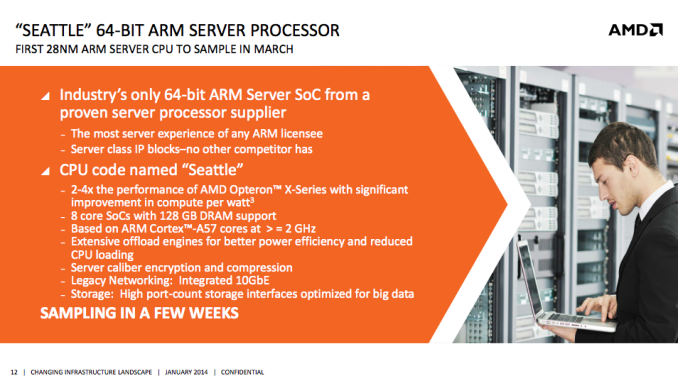
Around 15 months ago, AMD announced that it would be building 64-bit ARM based SoCs for servers in 2014. Less than a month into 2014, AMD made good on its promise and officially announced the Opteron A1100: a 64-bit ARM Cortex A57 based SoC.
The Opteron A1100 features either 4 or 8 AMD Cortex A57 cores. There's only a single die mask so we're talking about harvested die to make up the quad-core configuration. My guess is over time we'll see that go away entirely, but since we're at very early stages of talking about the A1100 there's likely some hedging of bets going on. Each core will run at a frequency somewhere north of 2GHz. The SoC is built on a 28nm process at Global Foundries.
Each pair of cores shares a 1MB L2 cache, for a total of up to 4MB of L2 cache for the chip. All cores share a unified L3 cache of up to 8MB in size. AMD designed a new memory controller for the Opteron A1100 that's capable of supporting both DDR3 or DDR4. The memory interface is 128-bits wide and supports up to 4 SODIMMs, UDIMMs or RDIMMs. AMD will be shipping a reference platform capable of supporting up to 128GB of Registered DDR3 DIMMs off of a single SoC.
Also on-die is an 8-lane PCIe 3.0 controller (1 x8 or 2 x4 slot configurations supported) and an 8-port 6Gbps SATA controller. AMD assured me that the on-chip fabric is capable of sustaining full bandwidth to all 8 SATA ports. The SoC features support for 2 x 10GbE ports and ARM's TrustZone technology.
AMD will be making a reference board available to interested parties starting in March, with server and OEM announcements to come in Q4 of this year.
It's still too early to talk about performance or TDPs, but AMD did indicate better overall performance than its Opteron X2150 (4-core 1.9GHz Jaguar) at a comparable TDP:
| AMD Opteron A1100 vs. X2150 | |||||||||
| CPU Core Configuration | CPU Frequency | SPECint_rate Estimate | SPECint per Core | Estimated TDP | |||||
| AMD Opteron A1100 | 8 x ARM Cortex A57 | >= 2GHz | 80 | 10 | 25W | ||||
| AMD Opteron X2150 | 4 x AMD Jaguar | 1.9GHz | 28.1 | 7 | 22W | ||||
AMD alluded to substantial cost savings over competing Intel solutions with support for similar memory capacities. AMD tells me we should expect a total "solution" price somewhere around 1/10th that of a competing high-end Xeon box, but it isn't offering specifics beyond that just yet. Given the Opteron X2150 performance/TDP comparison, I'm guessing we're looking at a similar ~$100 price point for the SoC. There's also no word on whether or not the SoC will leverage any of AMD's graphics IP.
The Opteron A1100 is aimed squarely at those applications that either need a lot of low power compute or tons of memory/storage. AMD sees huge demand in the memcached space, cold storage servers and Apache web front ends. The offer is pretty simple: take cost savings on the CPU front and pour it into more DRAM.
Early attempts at ARM based server designs were problematic given the lack of a 64-bit ARM ISA. With ARMv8 and the Cortex A53/A57 CPUs, that's all changed. I don't suspect solutions like the Opteron A1100 to be a knockout success immediately, but this is definitely the beginning of something very new. Of all of the players in the ARM enterprise space, AMD looks like one of the most credible threats. It's also a great way for AMD to rebuild its enterprise marketshare with a targeted strike in new/growing segments.
AMD's Andrew Feldman included one of his trademark reality check slides in his Opteron A1100 presentation today:
Lower cost, high volume CPUs have always won. That's how Intel took the server market to begin with. The implication here is that ARM will do the same to Intel. Predicting 25% of the server market by 2019 may be feasible, but I'm not fond of making predictions for what the world will look like 5 years from now.
The real question is what architecture(s) AMD plans to use to get to a leadership position among ARM CPUs and a substantial share of the x86 CPU market. We get the first hint with the third bullet above: "smaller more efficient x86 CPUs will be dominant in the x86 segment".


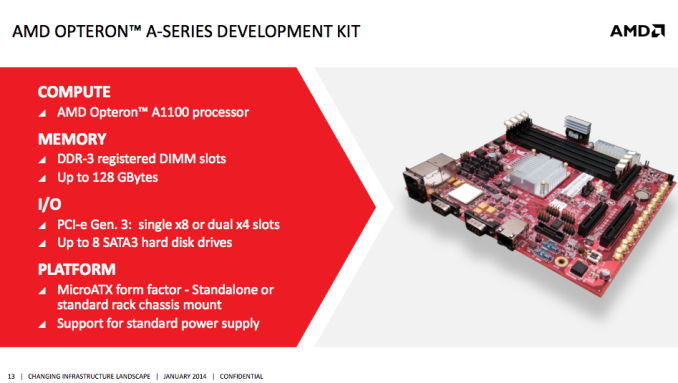
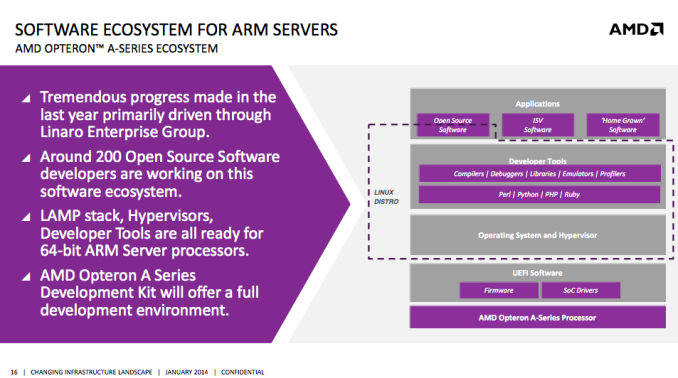
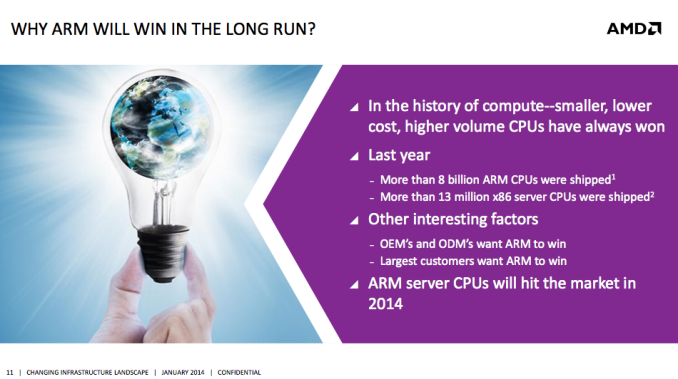
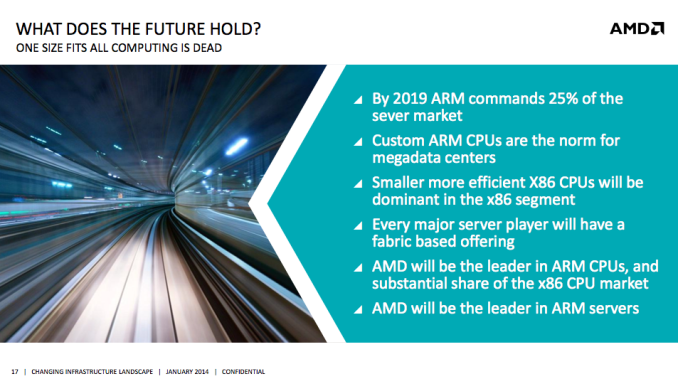








122 Comments
View All Comments
-wooki- - Saturday, February 15, 2014 - link
I love their slides, "Megadata centers" "commands"...hahahaha "smaller more efficient x86 cpu's" thanks captain obvious.Stick with what you know AMD, improve your x86 processors and take back market share. While my speculation is worthless here, ARM has little place in the market and even less soon when they are being dominated by 32,64 core x86 processors. I just struggle see the strategy here.
texadactyl - Wednesday, February 19, 2014 - link
The ARM strategy is not aimed at gaming desktops. They already have Android (Linux kernel) pretty much locked up and it is natural for them to evolve to other GNU/Linux system environments. For example, Redhat Enterprise Linux and other back-end GNU/Linux systems are seriously supporting ARM architectures because they see economic benefits in hardware competition. As a side-note, the open-hardware hobbyist community has moved completely to ARM because of support and cost reasons.In any case, time will tell what happens to Intel, AMD, and ARM. It should be interesting to watch the product evolutions as competition for our attention and $$ increases.
editorsorgtfo - Thursday, March 6, 2014 - link
> Anand said: "AMD assured me that the on-chip fabric is capable of ..."Apparently the first Chip has no clothes (much like http://en.wikipedia.org/wiki/The_Emperor's_New... ), the next Chip will.
Source: http://www.enterprisetech.com/2014/01/30/amd-appli... .
CNCJoe - Wednesday, April 30, 2014 - link
This really cant come soon enough. I have been dying each day since I saw these specs. I really hope they skip DDR3 and just go straight to DDR4. The second these are released I am picking up three of them. (router, NAS, desktop) specs:-A PF box with one nic to the modem, the second nic as DHCP to a managed switch, that pcie will be married to an AC1900 card, perhaps some SSD caching if my wallet allows
-A freeNAS box (hopefully) with teamed ports to the switch. 5-6 6TB drives (yeah right, 3 for now), again SSD caching as future option
-The desktop. I might have to put down the old horse they call windows and hook up a mule *cough* BSD *cough*. Who knows I might even try a diskless desktop, but most likely a pair of cheap SSDs (if win: raid 1; if BSD: raid z;) Again both ports to the switch, 20Gbps of glory.
Its been a while since I bought any new tech, I'm twitchy, restraining myself from buying new gigabit stuff. Its time to retire the noise-spewing space heaters.
Hurry up! I'm get'n grey over here!